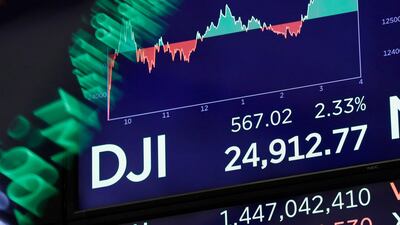US stocks continued their wild ride on Tuesday, plunging heavily before rallying amid frantic Wall Street trading triggered by losses around the world.
Three major indexes closed up by about two percentage points, wiping out some of the damage done on Monday, when US stock markets suffered their heaviest sell-off since 2011.
Traders are bracing for another day of ups and downs when markets open again on Wednesday morning even as the White House tried to steady expectations by talking up solid underlying fundamentals.
Investors fear rising interest rates could eat into the prospects of economic growth, bringing with it political risks for President Donald Trump who has staked his record on the stock market’s bullish run.
Critics said the sudden drops were a reminder that wise presidents should not claim credit for rising share prices.
Sarah Sanders, Mr Trump's press secretary, said the president had not had second thoughts about taking credit for rising markets.
“We’re infinitely better off today than we were before the president took office, particularly on the economy. We have historically low unemployment and we actually have increasing wages for American workers,” she said during her regular briefing.
“There’s nothing that’s taken place over the last couple of days in our economy that’s fundamentally different than it was two weeks ago and we’re very comfortable with where we are right now.”
The jitters set in on Friday after months and years of rising markets. A US department of labour report said wages were rising at their fastest rates since 2009, triggering inflation fears and the prospect of interest rate rises to cool an overheating economy.
That followed other factors such as tax cuts and a sinking dollar that some experts suggested could also fuel inflation.
On Monday the Dow Industrial Average plummeted more than 4 per cent, losing 1,175 points – its biggest numerical fall in history.
A day later it swung through more than 1,168 points to close up by 2.3 per cent or 567 points at 24,914.
Although analysts warned of ongoing volatility they also urged investors to remain calm, pointing out that so far enough money had been waiting on the sidelines to prop up sinking markets.
They also said the slide was part of a natural dip.
Adam Sarhan, chief executive of 50 Park Investments, an advisory service, said: “The markets went into being religiously over-bought to deeply over-sold in a matter of four trading days.
“The sell-off over the past few days is not a ‘normal’ sell-off by any means but it is not one that warrants panic either.
“Now, new buyers are showing up, who were waiting for the prices to go down. They are stepping in and buying. There was a lot of money in sidelines for the market to pull back.”
Global reaction
Earlier the turbulence on Wall Street sent shockwaves through global markets. On Tuesday, Germany's DAX, France's CAC 40 and the UK's FTSE 100 all registered falls of more than 2 per cent, before the US offered some hope that trading screens would bounce from red to green.
Tokyo stocks rebounded more than 3 per cent in opening trade on Wednesday with investors relieved to see New York's rally after sharp drops.
The benchmark Nikkei index, which fell nearly 5 per cent on Tuesday to suffer the worst loss since the November 2016 election of Mr Trump as US president, bounced back 3.13 per cent or 677.02 points to 22,287.26 in early trade.
The volatility presents deep problems for the Trump administration.
Immediately after his election in 2016, Mr Trump took credit for surging stocks, which he said helped Americans’ retirement accounts. On Twitter he recently boasted fresh gains would follow once his $1.5 trillion tax cut was “totally understood and appreciated”.
However, his administration is caught in a bind. Elected on a populist programme to help blue-collar America it has proudly trumpeted jobs growth.
With employment reaching near saturation, rising wages now threaten investor confidence.
At a Congressional hearing on Tuesday, Steven Mnuchin, the treasury secretary, was asked whether the administration would take any responsibility for the recent market drops.
“I think we will still claim credit for the fact that it is up 30 percent since the election,” he said.
But the recent losses served to illustrate the limited power of the presidency, according to Mark Doms, a senior economist at Nomura Securities.
“This is a healthy reminder that there are risks in the market,” he said. “If you invest in the stock market, there are ups and downs. We just hadn't had too many downs recently.”

